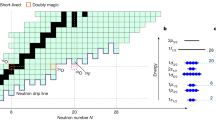Abstract
The degree of freedom of spin in quantum systems serves as an unparalleled laboratory where intriguing quantum physical properties can be observed, and the ability to control spin is a powerful tool in physics research. We propose a method for controlling spin in a system of rare isotopes which takes advantage of the mechanism of the projectile fragmentation reaction combined with the momentum-dispersion matching technique. The present method was verified in an experiment at the RIKEN RI Beam Factory, in which a degree of alignment of 8% was achieved for the spin of a rare isotope 32Al. The figure of merit for the present method was found to be greater than that of the conventional method by a factor of more than 50.
This is a preview of subscription content, access via your institution
Access options
Subscribe to this journal
Receive 12 print issues and online access
$209.00 per year
only $17.42 per issue
Buy this article
- Purchase on Springer Link
- Instant access to full article PDF
Prices may be subject to local taxes which are calculated during checkout





Similar content being viewed by others
References
Wolf, S. A. et al. Spintronics: A spin-based electronics vision for the future. Science 294, 1488–1495 (2001).
Benioff, P. Quantum mechanical models of Turing machines that dissipate no energy. Phys. Rev. Lett. 48, 1581–1585 (1982).
Neumann, P. et al. Multiparticle entanglement among single spins in diamond. Science 320, 1326–1329 (2008).
Kato, Y. K., Myers, R. C., Gossard, A. C. & Awschalom, D. D. Current-induced spin polarization in strained semiconductors. Phys. Rev. Lett. 93, 176601 (2004).
Kumada, N., Kamada, T., Miyashita, S., Hirayama, Y. & Fujisawa, T. Electric field induced nuclear spin resonance mediated by oscillating electron spin domains in GaAs-based semiconductors. Phys. Rev. Lett. 101, 137602 (2008).
Yano, Y. The RIKEN RI beam factory project: A status report. Nucl. Instrum. Methods B 261, 1009–1013 (2007).
Morrissey, D. J. for the NSCL StaffThe coupled cyclotron project at the NSCL. Nucl. Phys. A 616, 45–55 (1997).
Henning, W. The GSI project: An international facility for ions and antiprotons. Nucl. Phys. A 734, 654–660 (2004).
Geissel, H. et al. The super-FRS project at GSI. Nucl. Instrum. Methods B 204, 71–85 (2003).
Frank, M. On systematics in the 19F electric hyperfine interactions. Fortschr. Phys. 47, 335–388 (1995).
Bharuth-Ram, K. Hyperfine interaction studies in diamond. Physica B 389, 29–36 (2007).
Hüfner, J. & Nemes, M. C. Relativistic heavy ions measure the momentum distribution on the nuclear surface. Phys. Rev. C 23, 2538–2547 (1981).
Asahi, K. et al. New aspect of intermediate energy heavy ion reactions. Large spin polarization of fragments. Phys. Lett. B 251, 488–492 (1990).
Ishihara, M. et al. Spin-polarization measurement in the 197Au (19F, 12B) reaction. Prog. Res. 23–25 (1979).
Yoneda, K. et al. Deformation of 34Mg studied via in-beam γ-ray spectroscopy using radioactive-ion projectile fragmentation. Phys. Lett. B 499, 233–237 (2001).
Cohen, B. L. Resolution of accelerator magnetic analyzing systems. Rev. Sci. Instrum. 30, 415–418 (1959).
Blosser, H. G. et al. Ultra-high resolution spectrometer system for charged particle studies of nuclei. Nucl. Instrum. Methods 91, 61–65 (1971).
Kubo, T. In-flight RI beam separator BigRIPS at RIKEN and elsewhere in Japan. Nucl. Instrum. Methods B 204, 97–113 (2003).
Goldhaber, A. S. Statistical models of fragmentation processes. Phys. Lett. B 53, 306–308 (1974).
Morinaga, H. & Yamazaki, T. In-Beam Gamma-Ray Spectroscopy (North-Holland, 1976).
Robinson, M. et al. New isomer 32Alm. Phys. Rev. C 53, R1465 (1996).
Grévy, S. et al. Spectroscopy at the N = 20 shell closure: The β-decay of 32Mg. Nucl. Phys. A 734, 369–373 (2004).
Asahi, K. et al. Observation of spin-aligned secondary fragment beams of 14B. Phys. Rev. C 43, 456–460 (1991).
Schmidt-Ott, W-D. et al. Spin alignment of 43Sc produced in the fragmentation of 500 MeV/u 46Ti. Z. Phys. A 350, 215–219 (1994).
Fornal, B. et al. γ-ray studies of neutron-rich N = 18,19 nuclei produced in deep-inelastic collisions. Phys. Rev. C 55, 762–765 (1997).
Sümmerer, K. & Blank, B. Modified empirical parametrization of fragmentation cross sections. Phys. Rev. C 61, 034607 (2000).
Groh, D. E. et al. Spin polarization of 37K produced in a single-proton pickup reaction at intermediate energies. Phys. Rev. Lett. 90, 202502 (2003).
Acknowledgements
Experiments were performed under Program No. NP0702-RIBF018 at RIBF, operated by RIKEN Nishina Center and CNS, The University of Tokyo. We thank the RIKEN Ring Cyclotron staff for their cooperation during experiments. Y.I. is grateful to the Special Postdoctoral Researchers Program, RIKEN. This work was partly supported by the JSPS KAKENHI (22340071 and 20532089), by the JSPS and MAEE under the Japan-France Integrated Action Program (SAKURA), and by the Bulgarian National Science Fund (grant DID-02/16).
Author information
Authors and Affiliations
Contributions
Y. Ichikawa, H.U. and K.A. designed the experiments. H.U. is a spokesperson for the proposal of the present experiment at the RIBF, and the collaboration of all the other authors with him led to the accomplishment of the experiment. Y. Ichikawa and Y. Ishii analysed data. Y. Ichikawa, H.U. and K.A. chiefly wrote the paper.
Corresponding author
Ethics declarations
Competing interests
The authors declare no competing financial interests.
Rights and permissions
About this article
Cite this article
Ichikawa, Y., Ueno, H., Ishii, Y. et al. Production of spin-controlled rare isotope beams. Nature Phys 8, 918–922 (2012). https://doi.org/10.1038/nphys2457
Received:
Accepted:
Published:
Issue Date:
DOI: https://doi.org/10.1038/nphys2457
This article is cited by
-
gSPEC
Hyperfine Interactions (2019)
-
Interplay between nuclear shell evolution and shape deformation revealed by the magnetic moment of 75Cu
Nature Physics (2019)
-
Nuclear physics with RI Beam Factory
Frontiers of Physics (2018)
-
Dynamical effects of spin-dependent interactions in low- and intermediate-energy heavy-ion reactions
Frontiers of Physics (2015)
-
Slow neutron reactions in inverse kinematics for isotope production: a primer
Journal of Radioanalytical and Nuclear Chemistry (2014)



